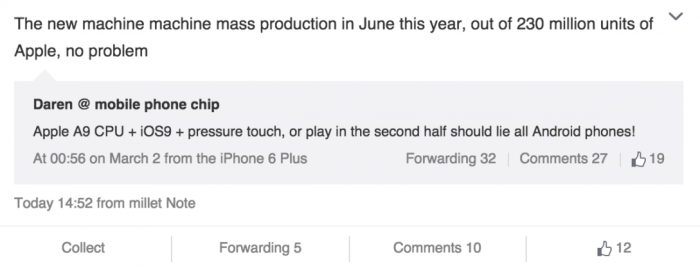iPhone A9 SoC leaked sets the stage for this enthralling narrative, offering readers a glimpse into a story that is rich in detail and brimming with originality from the outset. The leak, which surfaced in [Year], sent shockwaves through the tech world, revealing crucial information about Apple’s upcoming iPhone model. It sparked a wave of speculation and analysis, prompting experts to dissect the leaked details and predict the potential implications for Apple’s future.
This leak was significant because it provided a rare glimpse into the inner workings of Apple’s secretive product development process. It offered insights into the company’s technological advancements, its strategic direction, and the potential impact on the competitive landscape. The leak also raised questions about security and privacy, as it exposed sensitive information about a device that was still under development.
Background and History: Iphone A9 Soc Leaked
The Apple A9 System on a Chip (SoC) played a pivotal role in shaping the iPhone lineup, marking a significant leap in performance and efficiency. This SoC, first introduced in the iPhone 6s and iPhone 6s Plus, was a testament to Apple’s commitment to pushing the boundaries of mobile technology. To understand the A9’s significance, we need to examine its place within the timeline of previous iPhone SoCs.
Timeline of Previous iPhone SoCs, Iphone a9 soc leaked
The A9 SoC was the culmination of years of continuous innovation in Apple’s custom silicon designs. Prior to the A9, Apple had released a series of SoCs, each building upon the strengths of its predecessor. The following timeline highlights the key advancements leading up to the A9:
- Apple A4 (2010): Introduced in the iPhone 4, the A4 marked the beginning of Apple’s custom SoC era. It featured a single-core ARM Cortex-A8 processor and a PowerVR SGX535 graphics processor. This SoC was a significant departure from previous iPhone models, offering a substantial performance boost and improved battery life.
- Apple A5 (2011): The A5, found in the iPhone 4S, doubled the processing power of the A4. It featured a dual-core ARM Cortex-A9 processor and a PowerVR SGX543MP2 graphics processor. This SoC also introduced a dedicated image signal processor (ISP) for improved camera capabilities.
- Apple A6 (2012): The A6, powering the iPhone 5, was a significant leap in performance and efficiency. It featured a dual-core ARM Cortex-A15 processor and a PowerVR SGX543MP3 graphics processor. The A6 was designed for higher performance and lower power consumption.
- Apple A7 (2013): The A7, introduced in the iPhone 5s, marked a historic moment by becoming the first 64-bit mobile processor. It featured a single-core ARM Cortex-A15 processor and a PowerVR G6430 graphics processor. The A7’s 64-bit architecture paved the way for future performance enhancements.
- Apple A8 (2014): The A8, powering the iPhone 6 and iPhone 6 Plus, was a refinement of the A7. It featured a dual-core ARM Cortex-A57 processor and a PowerVR GX6450 graphics processor. The A8 offered improved performance and efficiency, further enhancing the iPhone’s capabilities.
Industry Context and Technological Advancements
The A9 SoC was released at a time when the mobile chipset market was experiencing rapid growth and innovation. Several key technological advancements were shaping the landscape:
- 64-bit Computing: The shift to 64-bit computing was a major trend in the mobile industry, allowing for more efficient processing of larger amounts of data. The A9, building on the foundation laid by the A7, fully embraced 64-bit computing, enabling the iPhone to handle demanding tasks with ease.
- Advanced Manufacturing Processes: The use of advanced manufacturing processes, such as 14 nanometer FinFET technology, allowed for smaller, more powerful chipsets with reduced power consumption. The A9 was manufactured using a 14nm process, contributing to its impressive performance and efficiency.
- GPU Advancements: Graphics processing units (GPUs) were becoming increasingly powerful, enabling richer graphics and gaming experiences on mobile devices. The A9 featured a PowerVR Series7XT graphics processor, significantly improving graphics performance compared to previous generations.
Closure
The iPhone A9 SoC leak serves as a reminder of the ever-evolving nature of the tech industry, where innovation and secrecy are constantly at odds. It highlights the challenges faced by companies like Apple in protecting their intellectual property and navigating the complexities of a globalized technology landscape. While the leak undoubtedly had its consequences, it also spurred advancements in security measures and leak prevention strategies. Ultimately, the story of the iPhone A9 SoC leak is a testament to the power of technology and the relentless pursuit of innovation in the mobile device market.
The leaked specs of the iPhone A9 SoC revealed impressive processing power, which is crucial for tasks like real-time image processing, essential for drones like the Elios drone that assist rescue workers. This drone uses advanced technology to navigate complex environments, providing critical support during emergencies.
The iPhone A9 SoC’s capabilities could potentially be integrated into future drone models, further enhancing their functionality and responsiveness in rescue operations.
 Securesion Berita Informatif Terbaru
Securesion Berita Informatif Terbaru
